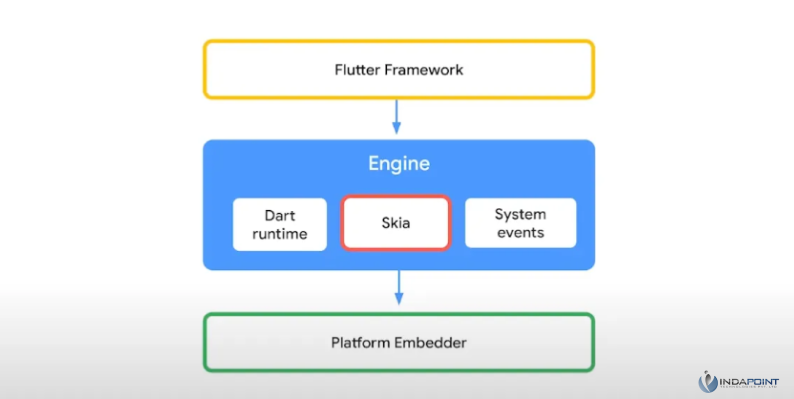React Native Vs. Flutter – Which Is the Best App Framework?
July 11, 2024

Choosing between React Native and Flutter depends on project needs and team expertise. React Native, with JavaScript and React, offers a mature ecosystem and cross-platform compatibility, ideal for developers familiar with these technologies. Flutter, using Dart, excels in performance and highly customizable UIs, suitable for multi-platform projects. Both frameworks deliver high-quality apps, but the choice hinges on UI complexity, performance needs, and developer proficiency.
React Native vs. Flutter – Which Is the Best App Framework?
In the ever-evolving landscape of mobile app development, choosing the right framework can make a significant difference in terms of efficiency, performance & user experience. Two of the most popular frameworks today are React Native and Flutter. Both have their own set of advantages and unique features that cater to different project needs. This blog aims to provide an in-depth comparison of React Native vs. Flutter, helping you decide which is the best app framework for your next project.
Overview of React Native
React Native, developed by Facebook is an open-source framework that allows developers to create mobile apps using JavaScript and React. Launched in 2015, it has gained immense popularity due to its ability to build cross-platform apps with a single codebase.
Key Features of React Native:
- Cross-Platform Compatibility : Write once, run anywhere – React Native enables developers to use the same codebase for both iOS and Android apps.
- Hot Reloading : This feature allows developers to instantly see the result of the latest change in the code without rebuilding the entire app.
- Rich Ecosystem : A vast library of third-party plugins and pre-built components enhances the development process.
- Community Support : Being a mature framework, React Native boasts a large community of developers who contribute to its growth and provide support.

Overview of Flutter
Flutter, developed by Google is another open-source framework for building natively compiled applications for mobile, web, and desktop from a single codebase. It was first released in 2017 and has quickly become a favorite among developers for its robust performance and rich set of features.
Key Features of Flutter:
- Single Codebase for Multiple Platforms : Flutter allows for the creation of apps for iOS, Android, web, and desktop using a single codebase.
- Hot Reload : Similar to React Native, Flutter offers hot reload, enabling quick iterations and debugging.
- Widgets : Flutter’s rich set of customizable widgets allows for creating highly expressive and flexible UI designs.
- Dart Programming Language : Flutter uses Dart, a language optimized for building UIs, which contributes to its fast performance and ease of use.
Performance Comparison
When it comes to performance, both React Native and Flutter have their strengths and weaknesses.
React Native Performance:
- JavaScript Bridge : React Native uses a bridge between JavaScript and native modules, which can sometimes result in performance bottlenecks, especially for complex applications.
- Native Components : React Native relies on native components, which can lead to better performance on certain UI elements.
Flutter Performance :

- Compiled to Native Code : Flutter apps are compiled directly to native ARM code, which often results in better performance compared to the JavaScript bridge approach.
- Skia Graphics Engine : Flutter uses the Skia graphics engine to render UI, providing smooth and fast performance.
Development Experience
React Native Development Experience:
- Familiarity with JavaScript : Developers who are already familiar with JavaScript and React will find it easy to transition to React Native.
- Mature Ecosystem : The extensive ecosystem of libraries and tools makes development faster and more efficient.
Flutter Development Experience:
- Expressive UI Design : Flutter’s widget system and customizability allow for highly expressive and visually appealing UI designs.
- Dart Learning Curve : Developers may need to invest time in learning Dart, but it is considered an easy-to-learn language with excellent documentation.
Community and Support
React Native Community:
- Established Community : With several years in the market, React Native has a large and active community of developers.
- Frequent Updates : Continuous updates and improvements ensure that React Native stays relevant and robust.
Flutter Community :
- Growing Fast : Although newer, Flutter’s community is growing rapidly, with significant contributions from developers worldwide.
- Strong Backing from Google : Regular updates and strong support from Google ensure a reliable framework.
Use Cases and Examples
React Native Use Cases:
- Facebook : The social media giant uses React Native for its mobile app, highlighting its capability to handle complex applications.
- Instagram : Another example is Instagram, which uses React Native to optimize its mobile experience.
Flutter Use Cases :
- Google Ads : The Google Ads app is built using Flutter, showcasing its ability to handle large-scale applications.
- Alibaba : The e-commerce giant Alibaba uses Flutter for some of its mobile applications, emphasizing its performance and flexibility.
Conclusion
Choosing between React Native & Flutter ultimately depends on your project requirements, team expertise & long-term goals. React Native is a mature framework with a robust ecosystem and is an excellent choice if you have a team experienced in JavaScript. On the other hand, Flutter offers exceptional performance, a highly customizable UI, and the advantage of being able to target multiple platforms from a single codebase..






